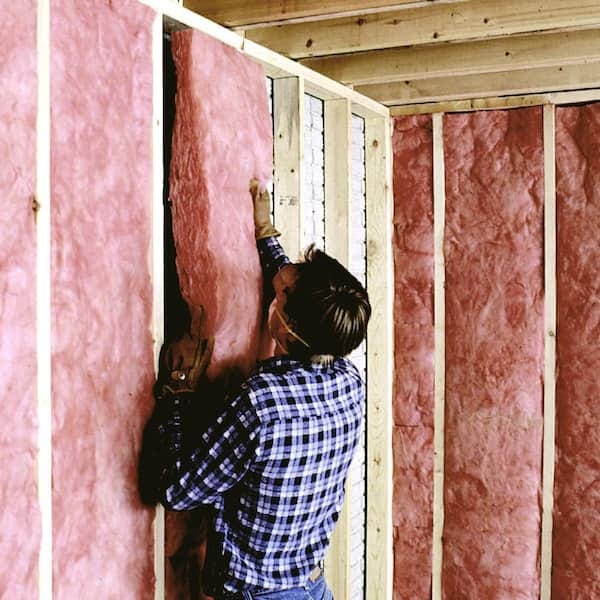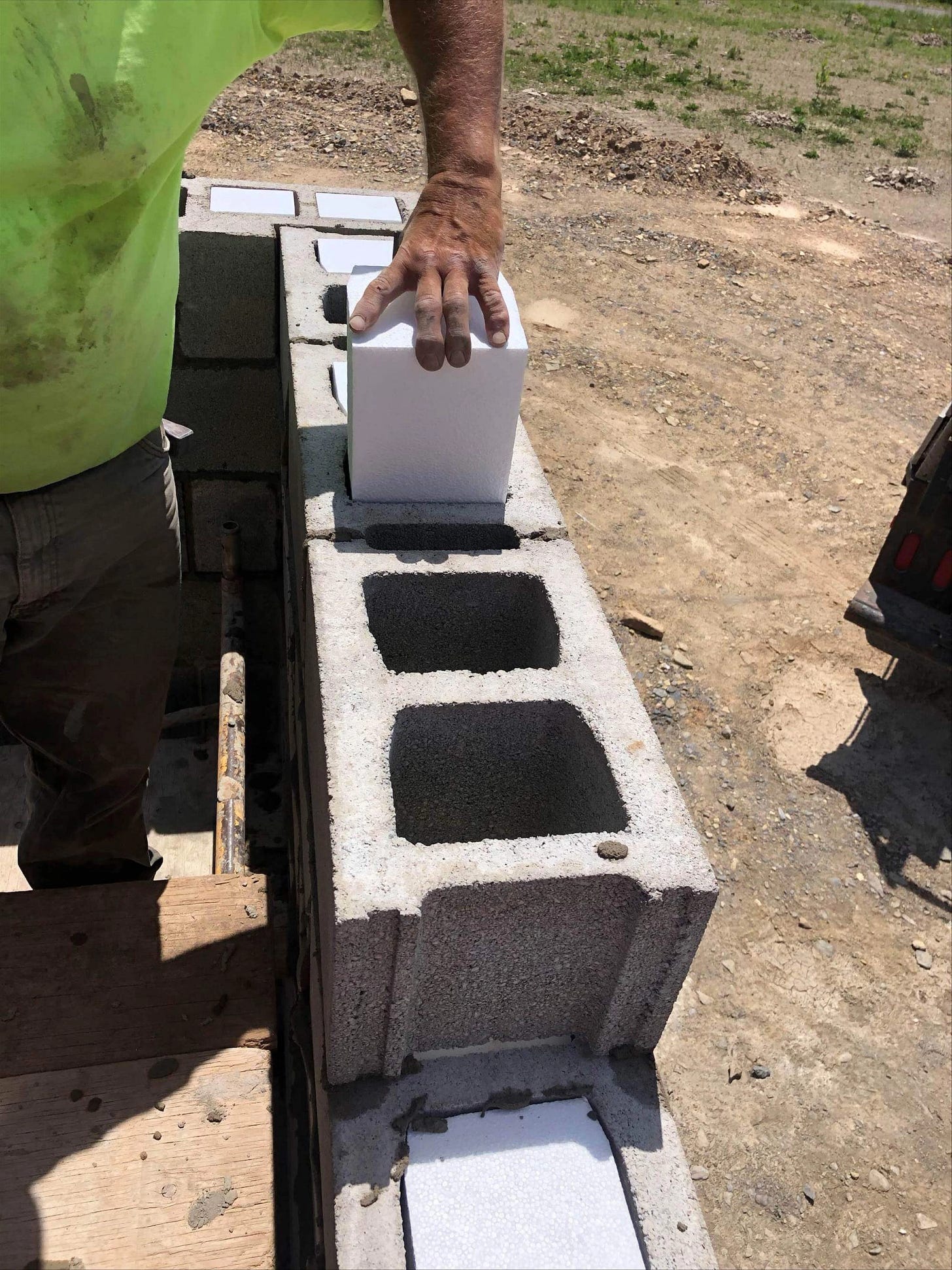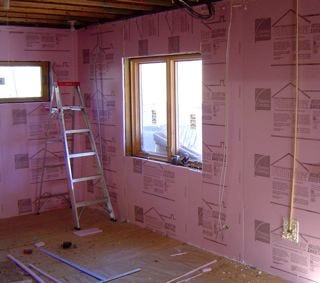Insulation: Construction material review
Part of an ongoing series on plastic use in modern building construction
The DOE has a nice blog post categorizing types of insulation. By mass, about a third of plastic produced in North America is used in construction; of this third, insulation probably accounts for between 20 and 25%. Saving you the mental math, that makes insulation account for somewhere between 6.6% and 8.25% of all plastic.

Insulating buildings is essential to maintaining appropriate temperature indoors, reducing energy waste from heating/cooling, soundproofing, and reducing vibrations. Frequently, insulation works by restricting airflow (which reduces ventilation). This can cause a tradeoff between indoor air quality and insulation, exacerbated by toxins and pollutants used in the construction of the building itself. The previous link is from EPA.gov, and it mentions that some of the “volatile organic compounds” (or VOCs) detected in indoor air are microplastics, plastic additives, and secondary pollutants carried in the insulation itself. Thus, as consumers, we ideally need a product which insulates well, pollutes indoor air as little as possible, and is otherwise practical to buy, install, and maintain. Because plastic foams, fibers, and forms release microplastics and VOCs into the indoor environment, they don’t constitute an acceptable choice.
Right off the bat, then, we can eliminate a few common insulation materials: fiberglass (which, although it does contain some glass fibers, is made of plastic), polystyrene (used in foam boards & as polystyrene beads), polyiso (short for polyisocyanurate, another type of plastic foam), polyurethane (the most common type of spray-foam insulation), and phenol-formaldehyde (sometimes called phenolic foam, literally made of a mixture of BPA and formaldehyde).
On the other hand, there are insulators which are very promising: mineral wool is a great insulator, not too expensive, and made usually by blowing air through metal slag from a foundry, molten rock, glass, or ceramic, to form extremely thin rock/slag fibers. This process doesn’t inherently involve any plastic at all, though the general trend with mineral wool products is to use plastic binders to keep all the mineral wool stuck together.
Other insulation materials can work too, like organic textiles (cotton, wool), wood products, and masonry materials. I’ll go over each of the common insulation form factors, which materials are available for each, what the industry standard is, and any other considerations below.
Blanket
Consisting of batts and rolls of soft fibrous material, blanket insulation is a common form factor for use in insulating walls and surfaces. The pink stuff shown in the image is probably familiar to the North American audience; this is generally made of fiberglass or recycled polyethylene, both of which are plastic. Mineral wool options that I’ve seen always use plastic binders to hold the fibers in place. This is still much, much better than the whole roll being made of PET, but I’d like to see a rigorous study quantify just how much of that plastic binder ends up in the air over the normal working life of these insulators.
For blanket insulation, it seems to me that there aren’t really any options in the US market that satisfy the zero-plastic goal; that said, just switching from the pink stuff to mineral wool probably accomplishes >95% of the goal.
Concrete Block
Concrete block insulation usually refers to concrete blocks with a hollow cavity filled with an insulator. One version of this is polystyrene concrete block, which is saturated with polystyrene beads. Another version uses a chemical reaction to fill concrete with air pockets; this is called AAC (autoclaved aerated concrete) or ACC (autoclaved cellular concrete). Sometimes, hollow cavities are filled with loose-fill insulation, straw, or even wood chips.
The main principle to use concrete-block insulation in zero-plastic construction is to look at the additives. Concrete alone isn’t a great insulator; in every case, something has to be applied to gaps in the concrete to reduce its thermal conduction. If that thing is plastic, like polystyrene beads or PET fiber insulation, it’s a no. If instead it’s air, straw, or a zero-plastic cellulose, it’s a yes.
Foam board & rigid foam
Foam boards are useful because they’re easy to store, handle, and install, and are more appropriate for unsupported and exterior insulation applications because they support their own weight without needing too much extra wall system. All foam board products on the market in North America are unfortunately made of plastic. If an efficient manufacturing process could be devised, maybe a zero-plastic competitor would take the form of thin wood veneer or kraft paper sheets, with cementitious foam or mineral wool sandwiched between them. As of now, though, zero-plastic construction with foam board insulation is not possible.
This is a shame, because rigid foam insulation is so useful in modular and prefabricated construction techniques. It would be nice to enjoy the efficiencies of prefab, while also cutting plastic use to 0. Maybe a product using rigid paper for structure, with mineral wool in between, would work for this purpose.
Loose fill and blown-in
This insulation type simply uses air pressure & a hose to fill a cavity (like a floor or wall) with loose fibers of insulation material. Thus, it works with zero-plastic construction as long as the fibers used aren’t made of plastic. Mineral wool (consisting of rock slag, glass, or other inorganic materials), cellulose, organic fabrics, or even straw can be used for this purpose. Avoid PET fill, polyethylene, or polyurethane.
One caution I need to issue about this technique is that it’s probably really important to only use this in well-enclosed spaces, NOT like shown in the picture. Without an adhesive or binder, whatever material you choose will surely end up floating in the air it’s exposed to. Mineral fibers (literally iron slag or molten rock fibers) are SUPER bad to inhale, responsible for horrifying cancers like the schoolyard classic “pneumonoultramicroscopicsilicovolcanoconiosis” (maybe not really, but definitely bad news to inhale). Loose fill is best for construction applications like the inside of walls; anything exposed to the air should be bound up in a neat package, in my opinion.
Rigid fiber
I didn’t remember what this was before writing this article, but the picture helped jog my memory: this stuff is put around HVAC ducts. It’s usually made of plastic foil adhered to fiberglass/mineral wool fabric. I can imagine an iteration of this product which uses only mineral wool & metal foil with some kind of mechanical bonding between them; that said nothing of the sort is available. I’d caution against using this to insulate air ducts, because the constant airflow will likely cause microplastic fallout, particularly if the air is heated, and the ducts will carry that fallout anywhere the air system leads. That said, insulating air ducts is really important for energy efficiency, particularly in large buildings, so if anyone wants to make millions of dollars selling to forward-thinking hospitals and such, they should develop a product for this niche which measurably doesn’t pollute the air.
Spray foam
Spray foam insulation, usually consisting of the expanding foam created when isocyanate is combined with polyol resin, is pretty much pure plastic. There does exist a type of air-hardening cement which can be sprayed in a similar fashion, called cementitious foam; that said, the actual use of this product seems minimal. I’d venture that this insulation form factor, despite its popularity, is probably a complete no-go for zero plastic construction.1
Thoughts
Insulation accounts for a massive percentage of all plastic use and production globally. Replacing the plastics we use in this sector with less polluting and less endocrine-disrupting materials will make a huge difference in health outcomes, fertility, ecological sustainability, and general quality of life in our societies. I’m not saying it will be easy or fast, but anyone who can get into this market ahead of the curve could make the world a much better place, and possibly a massive amount of money, have their name reverberate through the ages, etc.
To that end, efficiently manufacturing cellulosic insulation materials, mineral wool products without any major downsides, or as-yet-undiscovered alternative insulation products is a good life goal for someone talented and inclined to do something important. Particularly, a zero-plastic product which is cheap, easy to apply/can be prefabricated, and durable/insulating enough, could be a game-changer towards ending endocrine pollution in the modern economies, and plastic pollution globally.
My personal feeling is that mineral wool is a natural contender for replacing plastic in insulation, as its appearance/properties/form factors are so similar already to the plastic ones, other than spray foam. However, I’m not a chemist, and maybe there exist even better, cheaper, and more convenient options. The future is bright for anyone who wants to give a few years to exploring this question, and for the rest of us if they succeed!
An extra cheery thought which accompanies research into this topic is that spray foam insulation is inherently flammable. To mitigate fire risk, manufacturers therefore add flame retardants. Thus, at the end of life for buildings using spray foam insulation, all of the plastic foam inside of every wall, often hundreds of cubic meters, goes to a landfill, as it can’t be re-sprayed or otherwise reclaimed. Once in the landfill, it can’t even easily be burned, due to the flame retardant additives. Thus, it will sit there until it degrades, in 150,000 years. Extrapolating this trend, human history can be conceived of as the process of gradually covering the whole Earth’s surface with useless, inert plastic foam. If the land on Earth has a total surface area of 148,428,950,000,000 square meters, and an AI chatbot without any cited source estimates that global production is around 975.3 kT/yr, and each kilogram of spray foam able to cover about 10.7 square meters to 1 inch thickness, then quick & meaningless napkin math tells me we’re about .00702933834% of the way to our goal. Optimism :)










